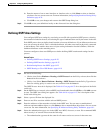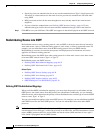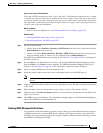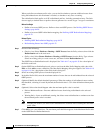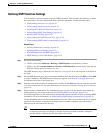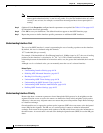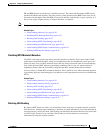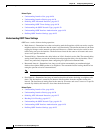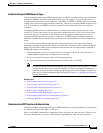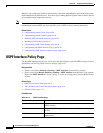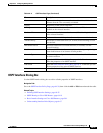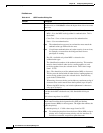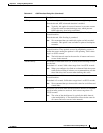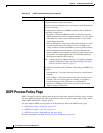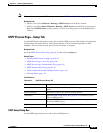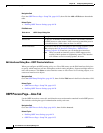
64-29
User Guide for Cisco Security Manager 4.4
OL-28826-01
Chapter 64 Configuring Routing Policies
OSPF Routing on Cisco IOS Routers
Understanding the OSPF Network Type
You can manually configure the OSPF network type on an interface as either broadcast or nonbroadcast
multiaccess (NBMA), regardless of the default media type. For example, you can use this feature to
configure broadcast networks (such as Ethernet, Token Ring, and FDDI) as NBMA when your network
contains routers that do not support multicast addressing. You can also configure NBMA networks (such
as X.25, Frame Relay, and SMDS) as broadcast networks, which eliminates the need to configure
neighbors.
Configuring NBMA networks as either broadcast or nonbroadcast assumes the existence of virtual
circuits (VCs) from every router to every router (fully meshed network). If VCs do not exist between
each router, due to cost constraints or the existence of an only partially meshed network, you can
configure the OSPF network type as point-to-multipoint. An OSPF point-to-multipoint interface is
defined as a numbered point-to-point interface having one or more neighbors. It creates multiple host
routes.
If you use the point-to-multipoint network type, routing between two routers that are not directly
connected go through a third router that has VCs to both routers. You do not need to configure neighbors
when using this feature. OSPF point-to-multipoint networks have the following benefits compared to
NBMA and point-to-point networks:
• Point-to-multipoint is easier to configure because it consumes only one IP subnet and does not
require neighbor configuration or designated router election.
• It costs less because it does not require a fully meshed topology.
• It is more reliable because it maintains connectivity in the event of VC failure.
Note For point-to-multipoint, broadcast networks, you can optionally define neighbors, in which
case you should specify the cost to each neighbor. For point-to-multipoint, nonbroadcast
networks, you must identify neighbors, but specifying a cost to each neighbor is optional. In
both cases, you define neighbors using FlexConfig. See Chapter 7, “Managing FlexConfigs”
for more information.
Related Topics
• Understanding Interface Cost, page 64-26
• Understanding Interface Priority, page 64-26
• Disabling MTU Mismatch Detection, page 64-27
• Blocking LSA Flooding, page 64-27
• Understanding OSPF Timer Settings, page 64-28
• Understanding OSPF Interface Authentication, page 64-29
• Defining OSPF Interface Settings, page 64-25
Understanding OSPF Interface Authentication
You define neighbor authentication settings for OSPF interfaces by selecting the interfaces and selecting
an authentication type, either MD5 or clear text.
When you use MD5 authentication, neighboring routers must share the same password. When you use
clear-text authentication, all routers on the network using OSPF must share the same password.



